In just a few years, TikTok has gone from a viral app for teens to a cultural and commercial powerhouse, shaping everything from fashion trends and music charts to how people shop and search.
And as someone who has been creating and consuming since before it was merged with Musical.ly, I know how valuable TikTok can be for both brands and creators.
Now that the platform is maturing, TikTok’s need-to-know numbers have shifted dramatically.
So in this roundup, we’ve pulled together the essential TikTok statistics you need to know in 2025 — whether you're building a brand, planning your next campaign, or just trying to keep up with what’s actually working on the platform.
TikTok user demographics show a young and growing audience
TikTok’s early growth may have cooled off, but it’s still gaining new users around the world, especially in regions where mobile-first platforms thrive. And while it’s no longer just for teens, TikTok remains the go-to app for younger users looking to explore, connect, and share what they love.
TikTok has 1.59 billion monthly active users
TikTok’s monthly active user base hit 1.59 billion globally in early 2025, solidifying its place as one of the top social platforms in the world, right up there with Instagram and YouTube. It is expected to reach 1.9 billion users in 2029.
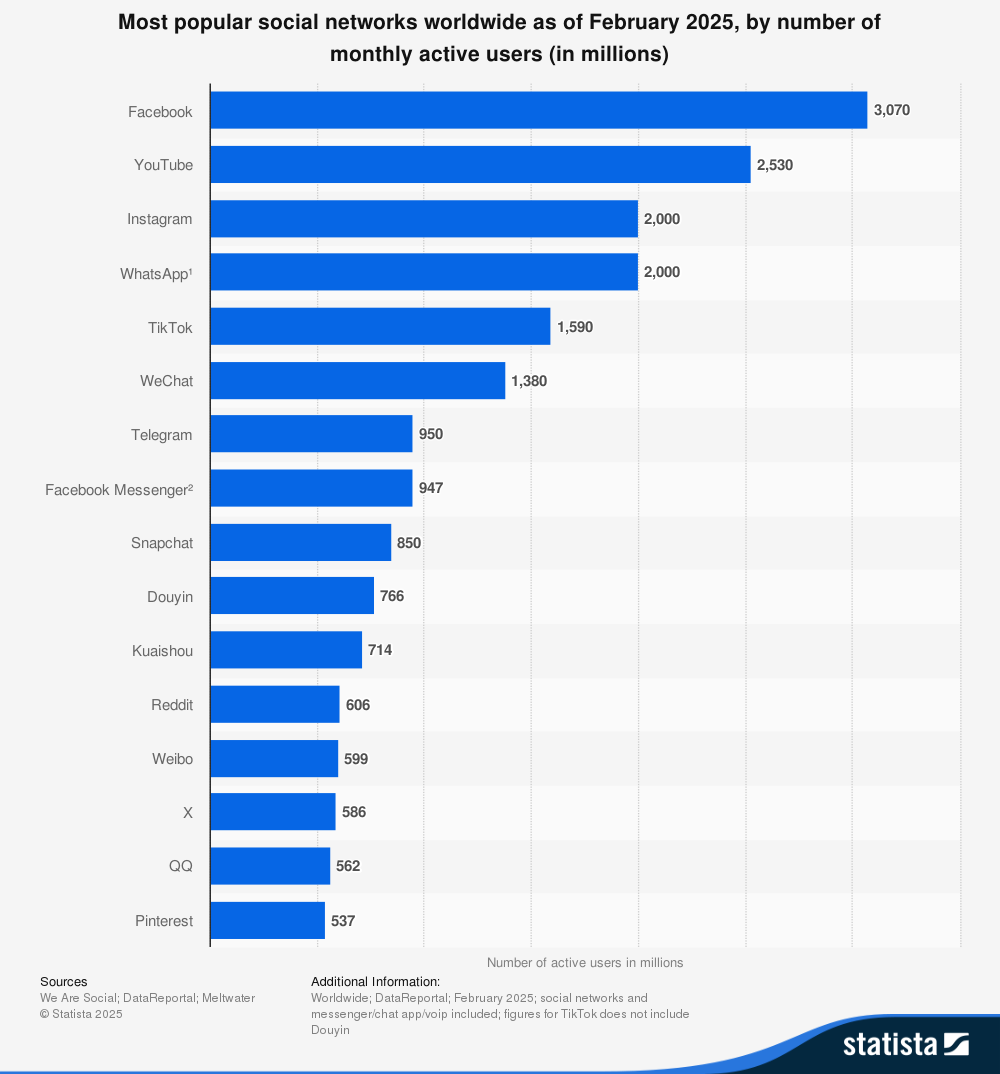
That growth is even more impressive when you remember how new TikTok still is. It started as a video app targeted towards Gen Z, but it’s quickly grown into a platform where all kinds of people — creators, brands, and communities alike — show up, connect, and build real momentum.
TikTok’s global audience leans slightly male
As of February 2025, 55.7% of TikTok users are male, while 44.3% are female. This is a helpful detail to keep in mind, especially if you’re tailoring content for a specific group or noticing differences in what’s landing with your audience.
Nearly 70% of TikTok’s user base is under 35
TikTok is still very much a youth-driven platform, and there’s no debate about it. Nearly 7 in 10 users globally are between 18 and 34 years old. The largest individual segments are men aged 25–34 (20.7%) and 18–24 (16.6%), followed closely by women aged 25–34 (14.6%) and 18–24 (14.1%).
That peek into the average user explains a lot about TikTok’s culture: fast, playful, full of in-jokes and trends that come and go overnight. From trending sounds to niche memes, TikTok moves at the speed of its youngest users — and that’s a big part of why it’s so influential.
More Gen Zers turn to TikTok for discovery than Instagram
Instagram may still top the list of the most-used social media platforms among Gen Z, but TikTok has become their top destination for discovery. Whether they’re looking for a new product, a niche community, or a breaking news update, Gen Z relies more on TikTok than any other app.
In fact, 77% of Gen Z say they use TikTok to discover new products, and 63% use it to keep up with the news, both higher than any other platform.
That habit of using TikTok to find things — not just scroll — is what makes the platform so powerful for creators and businesses alike.
The United States has the most TikTok users
As of February 2025, the U.S. leads worldwide in TikTok usage, with 135.79 million users. That’s nearly one in two American adults using the app regularly. Following close behind are Indonesia (107.7 million) and Brazil (91.75 million), showing just how global TikTok’s reach has become.
While the U.S. continues to dominate in total users, many of TikTok’s most engaged communities are emerging from countries in Asia, the Middle East, and Latin America — a signal that the most influential TikTok communities aren’t just in the U.S., they’re everywhere.
The UAE and Malaysia are among the countries with the highest TikTok adoption rate
In places where phones are the primary way people access the internet, TikTok is as much a part of daily life as calling or texting.
And its popularity isn’t just high — in some countries, it’s off the charts. In Saudi Arabia (133.7%), the UAE (118.5%), and Malaysia (108.7%), TikTok’s user numbers surpass 100% of the adult population. This accounts for users with multiple accounts and high adoption across age groups.
Other countries also show striking adoption rates:
- Vietnam: 94.5%
- Thailand: 91.5%
- Chile: 88.7%
- Mexico: 87.7%
- Indonesia: 82.5%
And in the U.S., TikTok reaches 120.5 million people — roughly 50.6% of the adult population.
South-Eastern Asia is the region with the highest number of users
TikTok’s global footprint looks different depending on where you zoom in. As of early 2025, South-Eastern Asia had the largest share of TikTok’s advertising audience, with 298 million users — that’s 18.7% of the worldwide total.
Here’s how other world regions compare in terms of active users:
- Southern America: 228 million (14.3%)
- Western Asia: 154 million (9.7%)
- Northern America: 149 million (9.3%)
- Southern Asia: 119 million (7.5%)
- Central America: 114 million (7.1%)
- Eastern Europe: 109 million (6.8%)
- Northern Africa: 90.9 million (5.7%)
- Western Europe: 57.5 million (3.6%)
- Southern Europe: 54.3 million (3.4%)
- Eastern Asia: 42.6 million (2.7%)
- Western Africa: 41.5 million (2.6%)
- Northern Europe: 37.2 million (2.3%)
- Eastern Africa: 21.9 million (1.4%)
- Southern Africa: 23.4 million (1.5%)
- Central Asia: 18.2 million (1.1%)
- Caribbean: 14 million (0.9%)
- Middle Africa: 11.6 million (0.7%)
- Oceania: 10 million (0.6%)
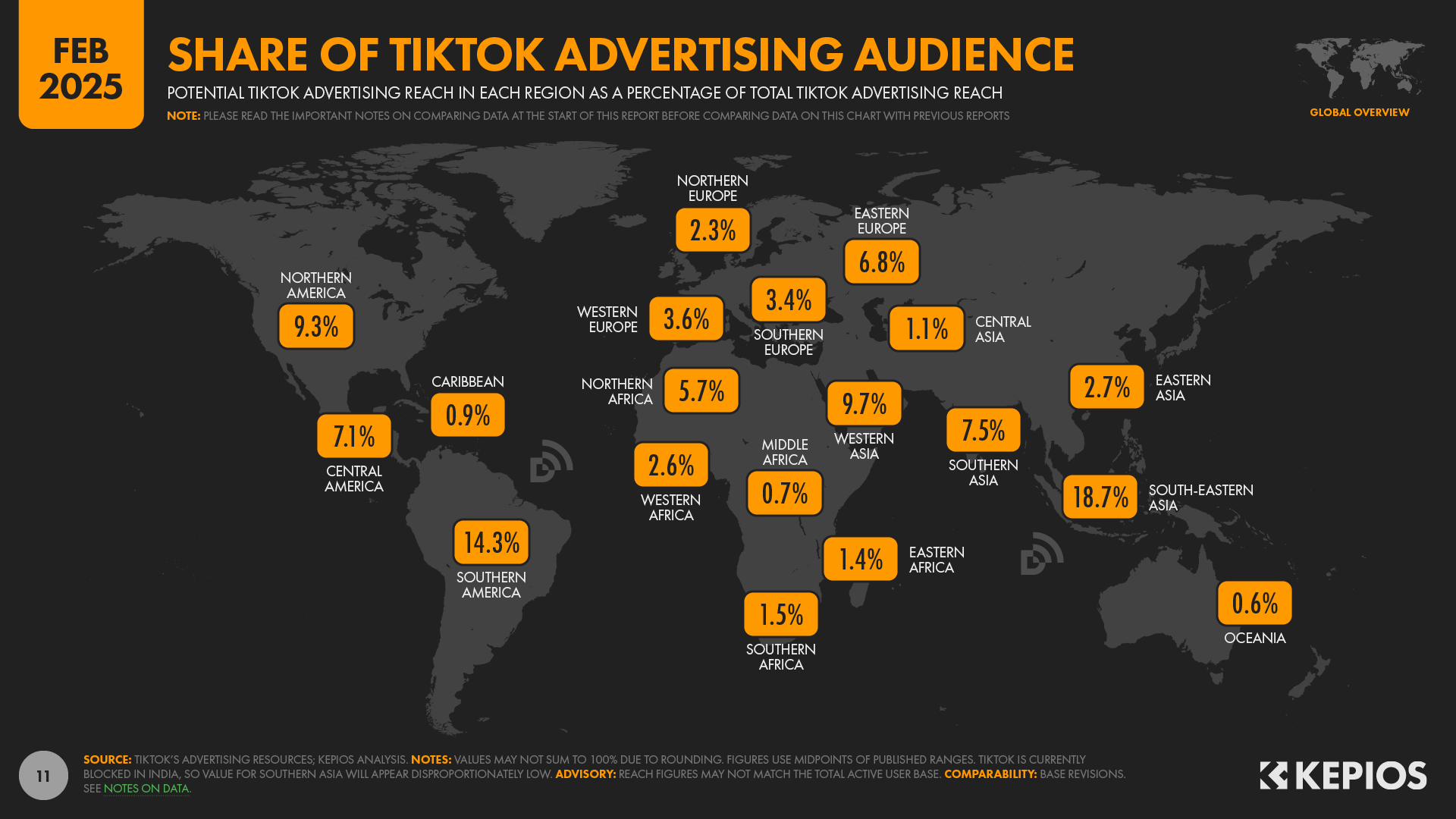
If you’re looking to reach new audiences, these regions could be your next best bet.
TikTok is the most rapidly adopted connection in Buffer
TikTok has grown since we added it to our list of platforms you can connect to in June 2022, from 779 connections in its first month to 276K connections by the end of 2024.
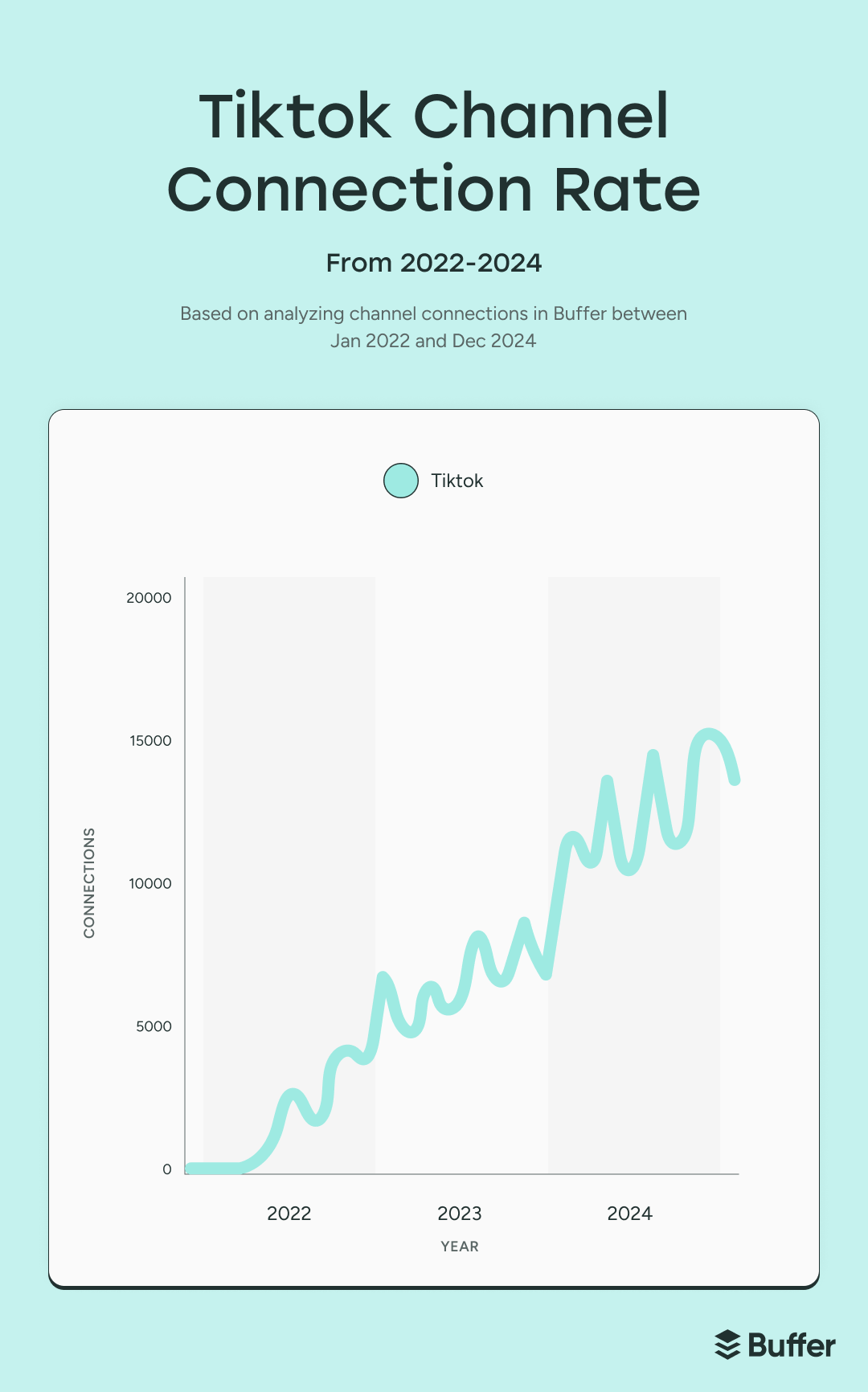
Of course, knowing who’s on TikTok is just one part of the picture. To really grow, it helps to understand how people use the app and what kinds of content they stick around for.
How users behave on TikTok
The way users behave on TikTok tells us everything we need to know about its influence: people spend hours on the app daily, and they’re not just watching videos — they’re sharing, shopping, and engaging.
Let’s break down what TikTok users are actually doing on the platform.
TikTok users spend an average of 95 minutes daily on the app
TikTok users love spending time on the app. Users average 34 hours per month and an average of 95 minutes daily on the platform, more than any other social network by a long shot.

The For You page, personalized discovery, and short-form storytelling make it highly addictive — and highly effective at holding attention.
45% of Gen Z TikTok users have shared a video with friends in the last month
TikTok content doesn’t just live on TikTok. Nearly half of Gen Z users (45%) say they’ve shared a TikTok video with friends in the past month, up from 37% in 2020.
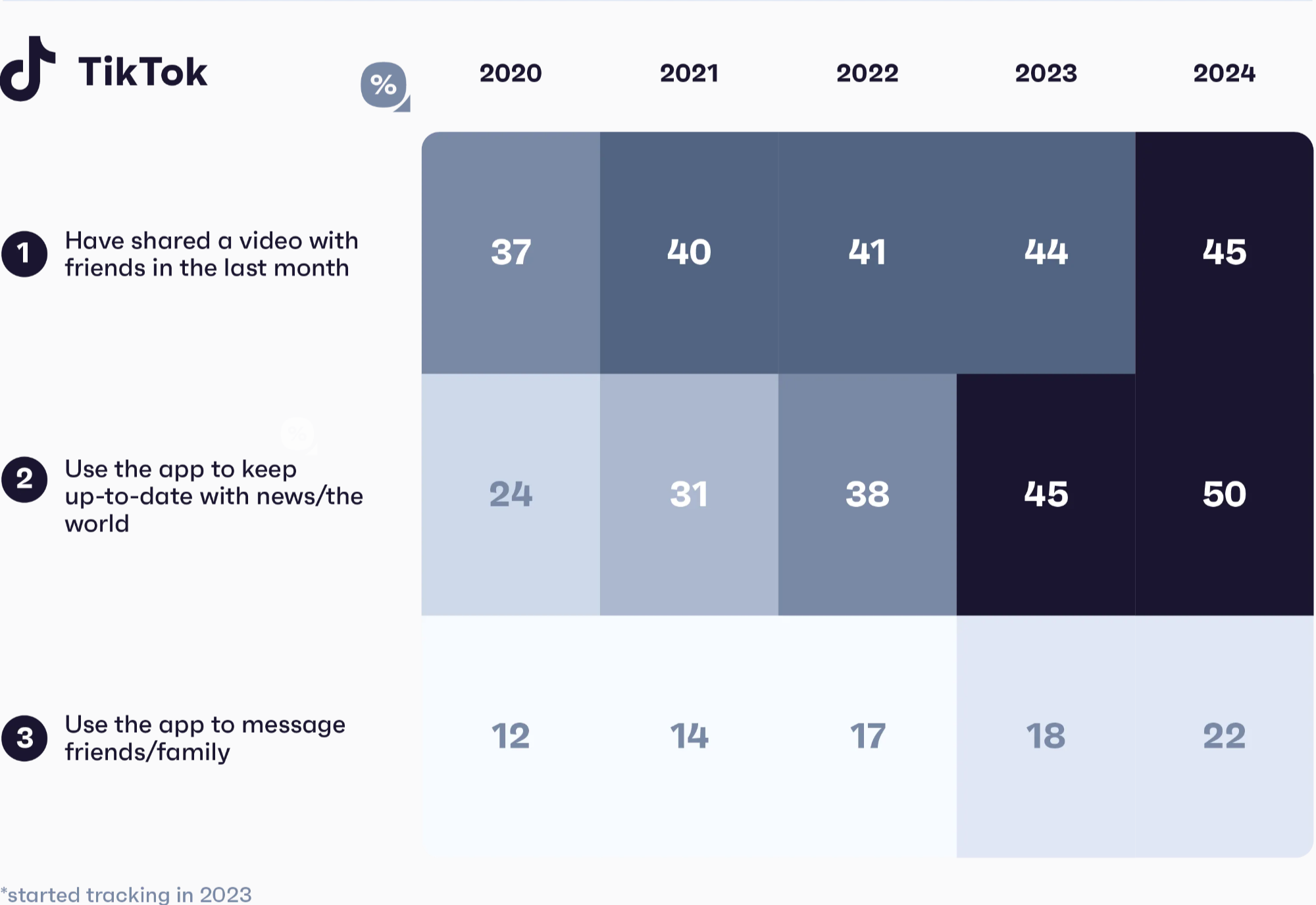
If you’re a creator or brand, this is your sign to create content that sparks a reaction. Think “send this to a friend”, not just “like and follow.”
Half of all TikTok users have made a purchase after watching a TikTok Live
According to TikTok, 50% of users have made a purchase after watching a TikTok Live.
It makes sense: Lives feel real and in-the-moment. You can set up real-time product demos, show honest reactions, and generate the kind of hype that makes people want to grab something right now.
If you’re launching a product, teaming up with a creator, or just trying to build buzz, going Live could be the extra push that gets your audience to take action.
TikTok is 150% better at convincing users to try a product or service
According to research from Material and TikTok, the platform is 150% more effective at getting users to try a product or service compared to other social networks.
That’s largely because TikTok doesn’t feel like traditional advertising or Google ads. It’s organic, often creator-led, and built on trust. Whether it’s a GRWM, a “TikTok made me buy it” moment, or a quick product demo in the comments, the content feels personal, and that makes it more persuasive.
Users are twice as likely to recommend a product discovered on TikTok
When people find something they love on TikTok, they talk about it — and not just in the comments. According to TikTok and Material, users are twice as likely to recommend a product they discovered on TikTok than one they found anywhere else.
That kind of genuine buzz gives every video the potential to go further than expected, in reach and real influence.
Tutorials are TikTok’s most-watched content — 62% of users prefer them
An Adobe Express study found that 62% of TikTok users say tutorials are their favorite videos, beating out product or service reviews (39%) and personal stories (38%).
Whether it’s a 30-second hack or a five-minute deep dive, “how-to” content taps into TikTok’s scroll-to-learn culture and routinely earns the highest completion and share rates.
For brands and creators, the takeaway is simple: teach first, sell second. Packaging your expertise into quick, actionable lessons is still the fastest route to the For You Page.
76% of TikTok users want a mix of images and video in their feed
TikTok may be video-first, but users don’t want only video. The platform’s 2025 What’s Next trend report shows that 76% of users say they enjoy both types of content.
For creators, that’s a green light to experiment. A photo-led day in the life post or image-based list of tips specific to your niche might be just as scroll-stopping as a video.
68% of TikTok users expect brands to mine the comments for insights
TikTok users don’t just read the comments — they treat them like part of the content. And they expect brands to do the same.
68% of users say that brands should pay more attention to what people are saying in the comments because they’re sharing feedback, asking questions, and generating ideas.
Content and content performance on TikTok
TikTok moves fast, and the content that performs well changes just as quickly. But some trends hold strong: video is still king, single image posts and carousels are on the rise, and smaller accounts are growing faster than ever.
Here's what the data says about what to post, how often, and why it works.
16,000 TikTok videos are uploaded every minute
Let that sink in: users are uploading more than 23 million videos per day. That makes TikTok one of the busiest platforms out there — and means that standing out takes more than just showing up.
For creators and brands, this stat is a reminder that volume alone won’t cut it. Posting frequently matters, but quality, timing, and creativity are what separate the scroll-stoppers from the background noise.
81% of TikTok users say the app introduced them to something they didn’t know they liked
TikTok isn’t just for things you’re already looking for — it’s for things you didn’t even know you wanted. In fact, 81% of users say the app introduced them to a product, topic, or community they’d never searched for before.
That’s part of what makes TikTok so powerful: it creates new demand. Lean into the unexpected — niche hooks, surprising formats, or overlooked communities — and you might catch attention from people who didn’t even know you existed yesterday.
The optimal posting frequency on TikTok is 1–4 times per week
According to our research, the optimal posting frequency is between 1 to 4 times per week — and that pace is working well. In fact, posting just a few high-quality videos per week can outperform daily content if it’s strategic and relevant to your audience.
That said, TikTok’s algorithm rewards consistency. If you’re looking to grow faster, ramping up to 5 or more posts per week can increase your chances of hitting the For You Page — especially for newer or smaller accounts still building momentum.
But the most important thing is sustainability. If daily posting leads to burnout or causes you to start making filler content, it’s better to dial it back and focus on strong, resonant posts.
The best time to post on TikTok is between 3 and 6 p.m.
Our data shows that posting between 3 and 6 p.m. local time tends to generate the highest engagement on TikTok — especially mid-week. This timeframe likely aligns with when users are finishing up school or work and reaching for their phones to scroll, search, and shop.
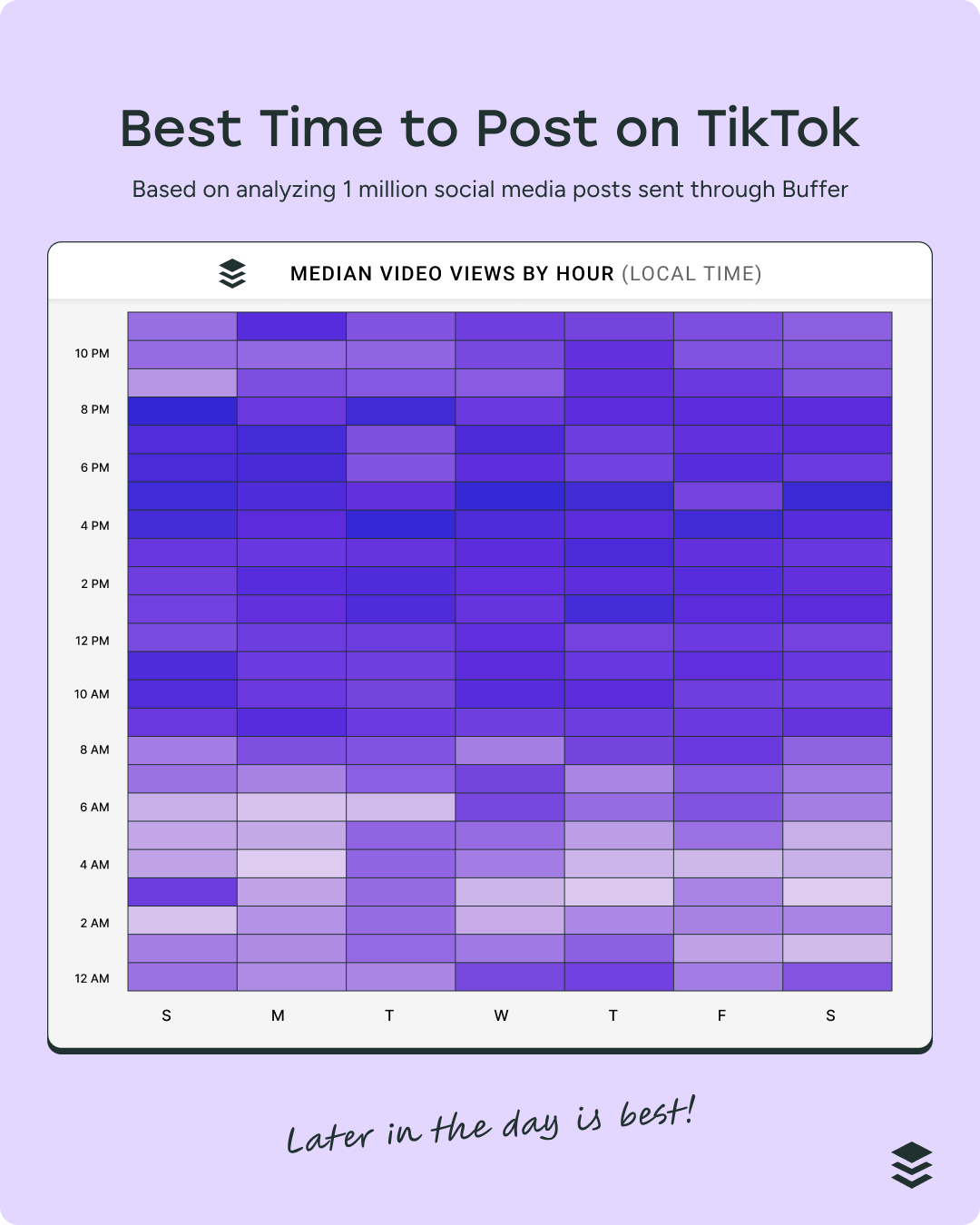
But here’s the catch: the best time to post varies by audience. While this 3–6 p.m. window is a helpful baseline, your content might perform better at different hours depending on your niche, region, and followers' behavior.
For the most accurate insight, check your TikTok analytics regularly and experiment with posting times to find your sweet spot.
The best content to post on TikTok is short-form video
On TikTok, short-form video is still king — but what you post matters just as much as how you post it.
We found that content types like educational tips, tutorials, and quick how-tos consistently outperform other formats on the platform. Think snackable insights, visually-led demonstrations, or personal stories with a clear takeaway.
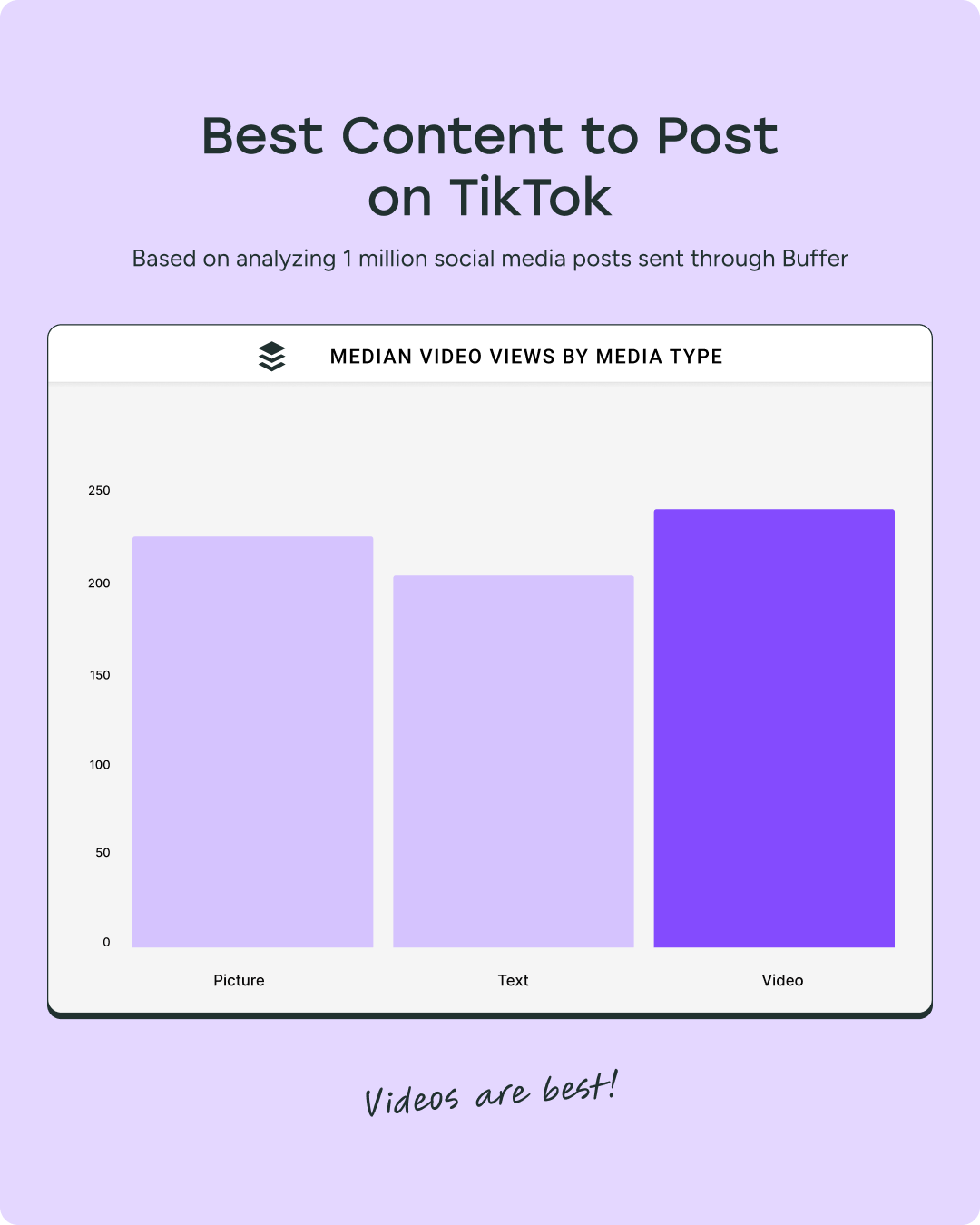
Text posts, images, and carousels are still emerging on TikTok and can work when used strategically, but video remains the default. If you're going to post something static, treat it like a visual story — not a recycled Instagram post.
Bottom line: post video-first, value-led content that teaches, entertains, or resonates emotionally.
The best day to post on TikTok is Wednesday
Our data shows that Wednesday is the best-performing day for engagement on TikTok, with the other days not far behind.
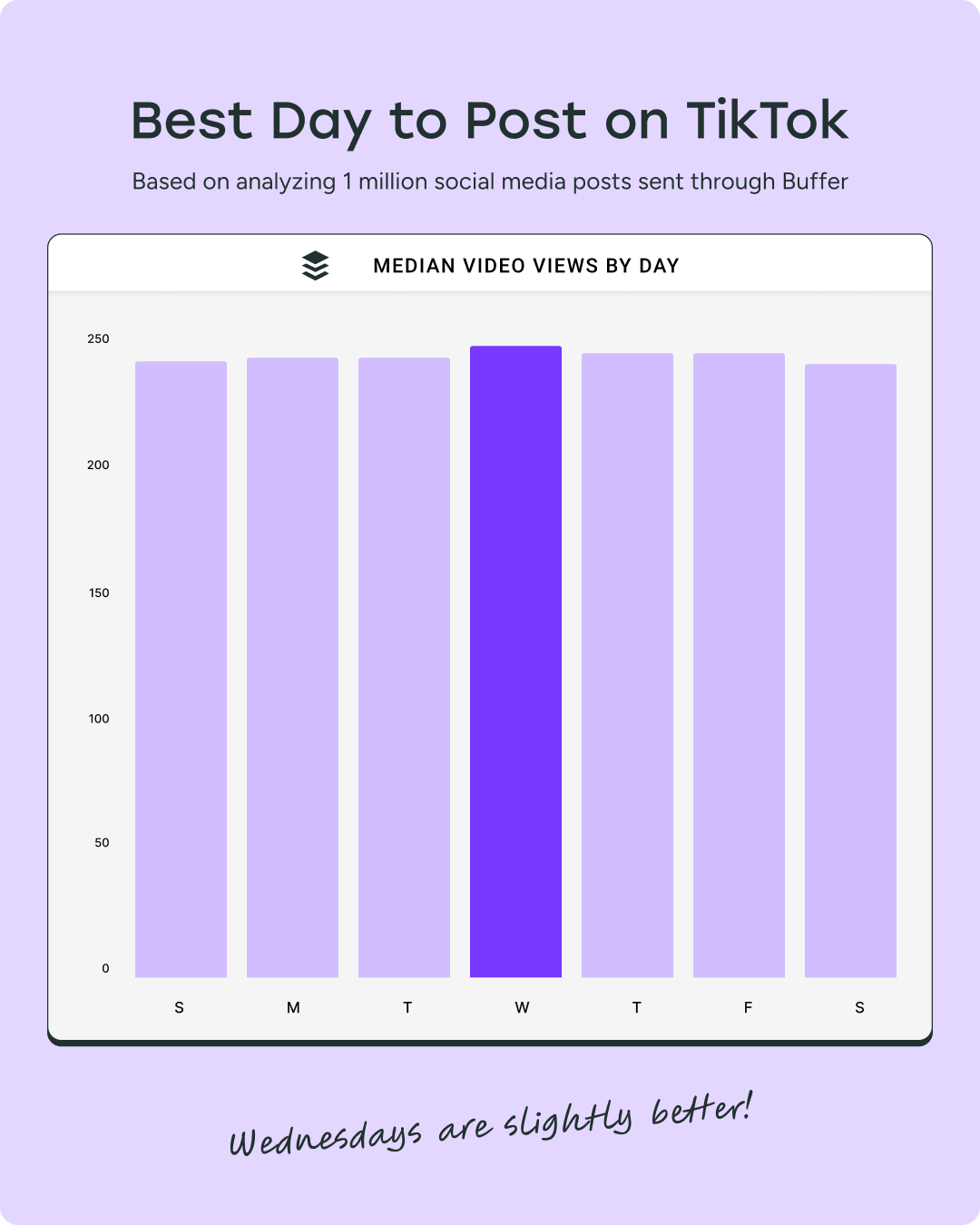
Wednesday is likely best because it sits at the sweet spot between midweek fatigue and weekend anticipation — a time when users are more likely to be passively scrolling, discovering new content, and engaging with posts they might not see earlier in the week.
That said, your best day may differ. Always monitor your analytics to align with your specific audience's habits.
Longer videos perform better on TikTok — especially between 3 to 10 minutes
While TikTok started with short-form clips, the platform has evolved — and so has user behavior. We discovered that videos between 3 to 10 minutes long now perform better than ultra-short ones in terms of engagement and watch time.
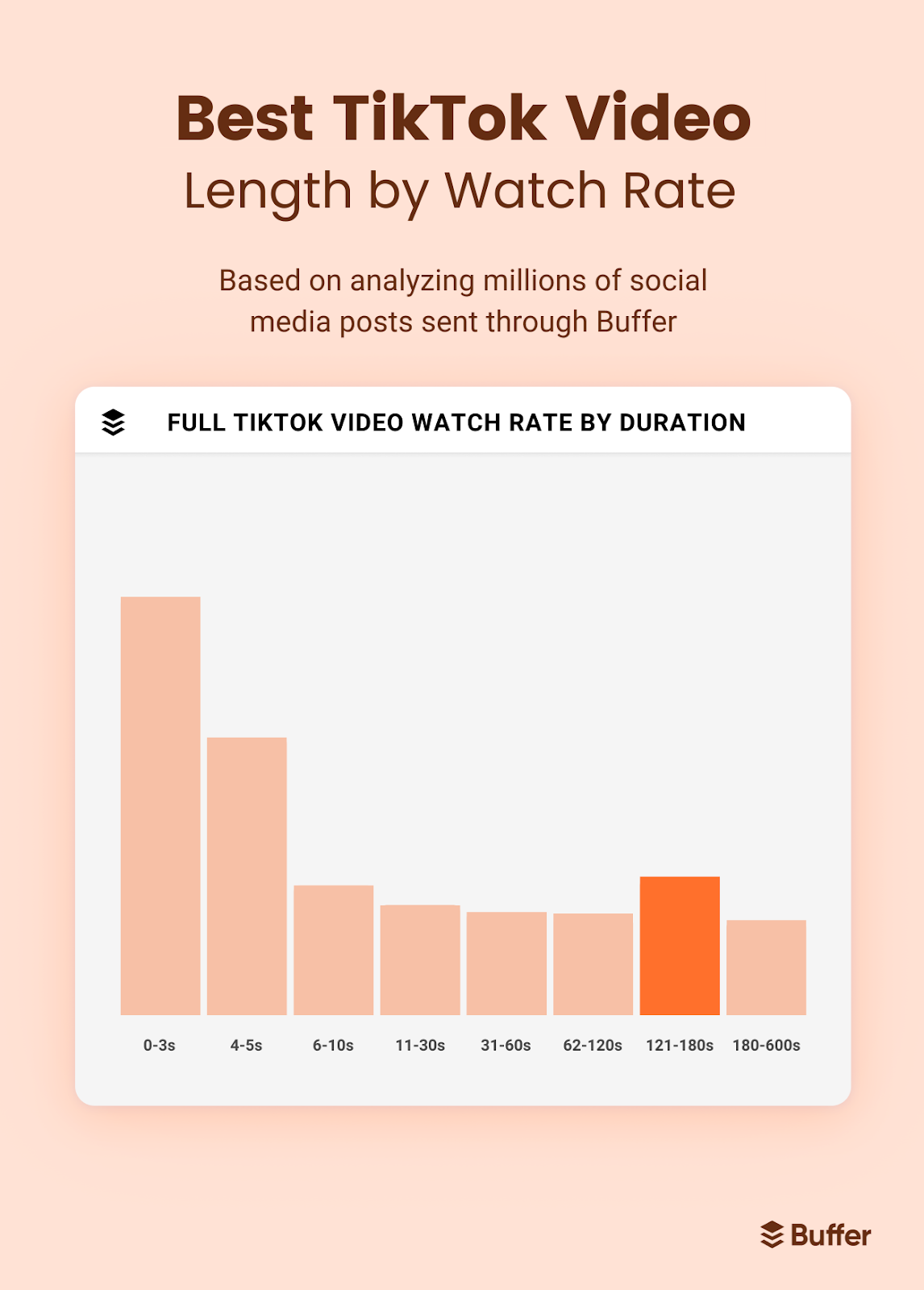
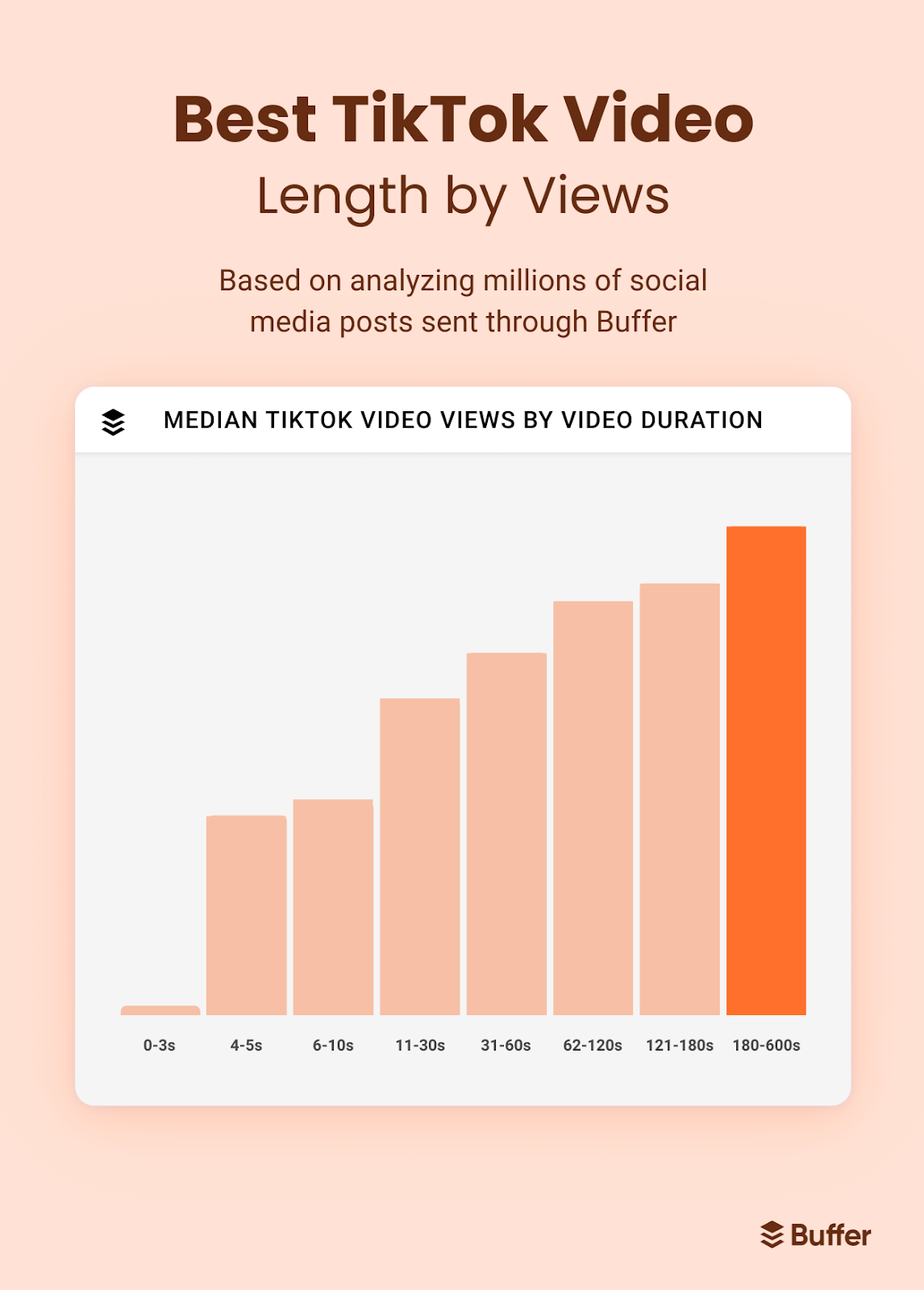
That doesn’t mean every post needs to be long. But it does signal a shift: users are willing to stick around for content that provides deeper value, whether that’s an in-depth tutorial, a compelling story, or a multi-part narrative packed into a single post.
TikTok now supports uploads up to 30 minutes, but most high-performing long videos fall in that 3–10 minute sweet spot — long enough to engage, short enough to hold attention.
TikTok’s engagement rate sits at 4.86%
Our engagement study ranks TikTok third overall, with an average engagement rate of 4.86% (behind LinkedIn’s 6.50% and Facebook’s 5.07%). While that’s still ahead of YouTube Shorts, Threads, and Instagram, TikTok’s median engagement rate has edged down from 5.14% in January 2024 to 4.56% in January 2025.
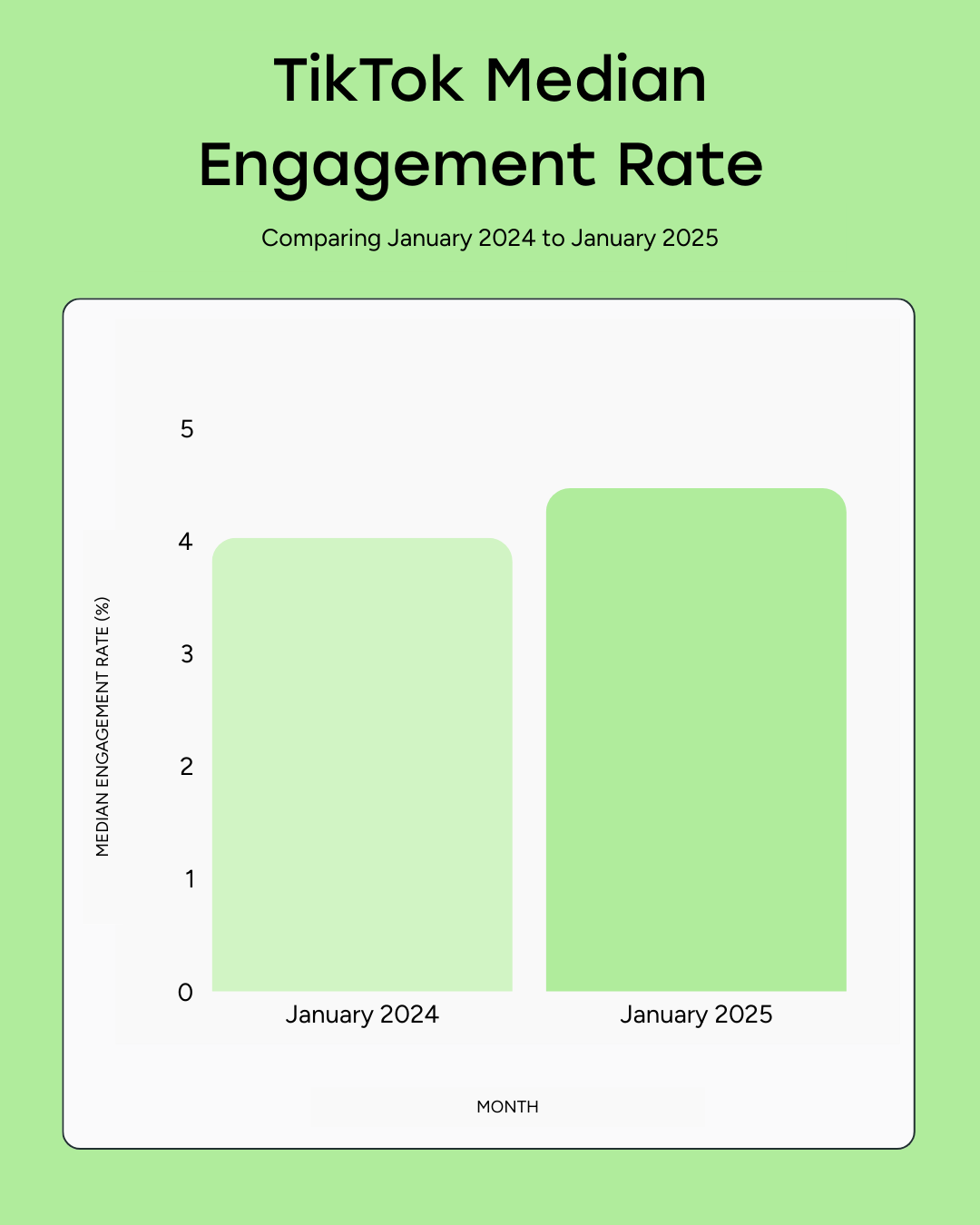
We noted three shifts that might explain this:
- Algorithm tweaks prioritize watch-time and replays over visible interactions such as likes or comments.
- Heavier short-form video competition from reels, shorts, and even LinkedIn video.
- More polished brand content, which can dilute the raw, community-driven feel that once super-charged engagement.
Focus on content that keeps viewers watching and sharing — not just tapping the like button.
Big accounts get more views — but that’s not the whole story
According to Socialinsider, large accounts consistently get more likes, comments, shares, and views per post. That’s expected — more followers mean more eyeballs.
| Account size | Avg. likes / post | Avg. comments / post | Avg. shares / post | Avg. views / post |
|---|---|---|---|---|
| 1K–5K | lowest | lowest | lowest | lowest |
| 5K–10K | ↑ | ↑ | ↑ | ↑ |
| 10K–50K | ↑↑ | ↑↑ | ↑↑ | ↑↑ |
| 50K–100K | ↑↑↑ | ↑↑↑ | ↑↑↑ | ↑↑↑ |
| 100K–1 M | highest | highest | highest | highest |
But that doesn’t mean smaller accounts can’t win. While big profiles get the volume, small creators often win at rates as they get more engagement per view, faster growth, and deeper audience connection.
Smaller TikTok accounts grow faster than large ones
Here’s some encouraging news if you’re just starting out: accounts with 1K–5K followers are growing 8x faster than those with over 100K.
According to Socialinsider, accounts with 1K–5K followers saw an average growth rate of 269%, compared to just 33% for accounts with over 100K followers.
The smaller the account, the easier it is to pivot quickly, experiment often, and connect with an audience on a more personal level.
Smaller accounts publish more carousels on TikTok
Carousels are still a small slice of TikTok content overall — but interestingly, smaller accounts use them more often than larger ones. According to Socialinsider, here’s how carousel usage breaks down by account size:
- 1K–5K followers: 3.14% of posts
- 5K–10K: 2.17%
- 10K–50K: 2.35%
- 50K–100K: 1.71%
- 100K–1M: 1.49%
This suggests that smaller creators may be more willing to experiment with newer or underused formats, or they may be leaning into static content as a lower-effort way to stay consistent.
Either way, there’s an opportunity here. Since most TikTok content is still video, carousels offer a way to stand out, especially when paired with strong storytelling or visual hooks.
Brands and creators on TikTok
Creators are the engine behind TikTok, whether they’re filming quick takes from their bedrooms or partnering with global brands. And the good news? The platform rewards content at every level, from nano to mega.
Here’s what the latest data tells us about how creators and brands connect, as well as what it costs to collaborate effectively.
40% of TikTok users say a brand’s personality makes it more relevant
Highly polished content might look nice, but it doesn’t always land with TikTok users. The platform is built for content that feels human: off-the-cuff, a little scrappy, and full of personality.
In TikTok’s 2025 What’s Next trend report, 40% of users say a brand’s personality is what makes it feel relevant on the platform.
That means humor, behind-the-scenes moments, and creator-style storytelling go a lot further than a corporate voice or studio-quality promo. If you're showing up on TikTok, make it human. Personality isn’t just a nice touch — it’s the thing that makes people care.
61% of marketers use TikTok for influencer marketing
TikTok has cemented itself as a core channel in the creator economy. Hubspot found that 61% of marketers now collaborate with influencers on TikTok, making it the third-most-used influencer platform after Instagram and YouTube.
TikTok nano-influencer posts have an 18% engagement rate on average
Posts from TikTok creators generate significant engagement across all types of creators, from nano to mega creators, solidly ahead of Instagram and YouTube Shorts, according to Grin. Here’s how it breaks down:
- Nano influencers (1-10K followers): 18% engagement rate
- Micro influencers (10K-100K followers): 12% engagement rate
- Macro influencers (100K-1M followers): 8% engagement rate
- Mega or celebrity influencers (1M+ followers): 4% engagement rate
For brands, this means TikTok partnerships still deliver strong interaction, especially when paired with native, story‐driven content.
Content on TikTok can range in pricing from $50 to $10,000
Modash did the research and uncovered ballpark pricing for creators. Before we get into it, note that this data is specific to North America. And pricing will change from region to region and niche to niche. But these numbers can act as a starting point.
Here are the numbers for each tier:
- Nano influencers (1-0K followers): $50 to $200
- Micro influencers (10k-100K followers): $200 to $1000
- Mid-tier influencers (100k-500K followers): $1000 to $5000
- Macro influencers (500K -1 M followers): $5000 to $10,000
- Mega or celebrity influencers (500K-1M followers): $10,000+
Factors like usage rights, deliverables, and exclusivity also play a role. The best partnerships happen when both sides are clear about what’s expected, and when creators are treated like creative collaborators, not just ad space.
What these TikTok statistics mean for your strategy in 2025
With more than 1.5 billion monthly users and a role in everything from entertainment to search, TikTok has grown into more than just a social app. It’s where people go to learn, laugh, connect, and buy — often all in the same scroll.
The data shows us that:
- Story-driven content fuels discovery on TikTok and in search
- Content can (and should) be playful and useful
- Being small can be a strength for creators and the brands that partner with them
But behind those stats is an even more interesting shift: TikTok is a non-negotiable for creators and brands. It’s where audiences look for answers, follow for relatability, and stay for personality.
You don’t need to jump on every trend or reinvent yourself for the algorithm. Show up clearly, consistently, and in a way that feels unmistakably you.
Let the numbers guide you and trust your instincts, lean into your strengths to build something worth following.
Sources
https://explodingtopics.com/blog/time-spent-on-tiktok
https://explodingtopics.com/blog/tiktok-demographics
https://www.statista.com/topics/6077/tiktok/
https://thesocialshepherd.com/blog/tiktok-statistics
https://backlinko.com/tiktok-users
https://datareportal.com/essential-tiktok-stats
https://sproutsocial.com/insights/tiktok-stats/
https://www.meltwater.com/en/blog/tiktok-statistics
https://www.demandsage.com/tiktok-user-statistics/
https://influencermarketinghub.com/tiktok-stats/
https://blog.hootsuite.com/tiktok-stats/
https://www.socialinsider.io/social-media-benchmarks/tiktok
https://keywordseverywhere.com/blog/tiktok-advertising-stats/
https://www.adobe.com/express/learn/blog/using-tiktok-as-a-search-engine
Try Buffer for free
190,000+ creators, small businesses, and marketers use Buffer to grow their audiences every month.




